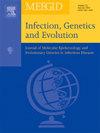A simple improved method for extracting DNA from ethanol-preserved hard ticks and its applications
IF 2.6
4区 医学
Q3 INFECTIOUS DISEASES
引用次数: 0
Abstract
Hard tick exoskeletons, composed primarily of chitin, pose a significant challenge for researchers attempting to extract genetic material. This study presents a simple modified, alternative method for extracting DNA from ethanol-preserved hard ticks. The extracted DNA was further used for PCR amplification of phylogenetic markers for population genetics studies. The study also improvises the DNA extraction methods from commercial kits. We have used four DNA extraction methods: Modified Simple Alkaline Lysis, and other commercial kit-based methods (Kit X, Kit Y & Kit Z). The modified method for DNA extraction yielded comparable results in terms of concentration, and purity from all the life stages (adult, nymph, and larvae). The extracted DNA from each method was quantified and subjected to PCR amplification of molecular markers, ITS-1 and ITS-2. The nucleotide sequences from both markers were characterized for the first time and used for phylogenetic analysis of Amblyomma integrum, which is a potential vector for Kyasanur Forest Disease Virus (KFDV), causing monkey fever disease in India. These results demonstrate a cost-effective approach for isolating genomic DNA suitable for PCR amplification and subsequent nucleotide sequencing. Importantly, this simple method offers an option for population genetics study in resource-limited settings, facilitating field research with minimal equipment requirements. Additionally, the study showed tick homogenization can significantly improve DNA yield from commercial kits.

一种从乙醇保存的硬蜱中提取DNA的简单改进方法及其应用。
主要由几丁质组成的硬蜱外骨骼对试图提取遗传物质的研究人员构成了重大挑战。本研究提出了一种简单的改进的替代方法,用于从乙醇保存的硬蜱中提取DNA。提取的DNA进一步用于PCR扩增系统发育标记,用于群体遗传学研究。该研究还改进了商业试剂盒的DNA提取方法。我们使用了四种DNA提取方法:改良的简单碱性裂解法和其他基于商业试剂盒的方法(Kit X, Kit Y和Kit Z)。改良的DNA提取方法在所有生命阶段(成虫,蛹和幼虫)的浓度和纯度方面产生了相当的结果。对每种方法提取的DNA进行定量,并对分子标记ITS-1和ITS-2进行PCR扩增。首次对这两个标记的核苷酸序列进行了鉴定,并将其用于对印度猴热病的潜在病媒——印度森林病病毒(KFDV)的系统发育分析。这些结果证明了一种具有成本效益的方法来分离适合PCR扩增和随后的核苷酸测序的基因组DNA。重要的是,这种简单的方法为资源有限的环境下的群体遗传学研究提供了一种选择,以最小的设备要求促进了实地研究。此外,研究表明蜱均质化可以显著提高商业试剂盒的DNA产量。
本文章由计算机程序翻译,如有差异,请以英文原文为准。
求助全文
约1分钟内获得全文
求助全文
来源期刊

Infection Genetics and Evolution
医学-传染病学
CiteScore
8.40
自引率
0.00%
发文量
215
审稿时长
82 days
期刊介绍:
(aka Journal of Molecular Epidemiology and Evolutionary Genetics of Infectious Diseases -- MEEGID)
Infectious diseases constitute one of the main challenges to medical science in the coming century. The impressive development of molecular megatechnologies and of bioinformatics have greatly increased our knowledge of the evolution, transmission and pathogenicity of infectious diseases. Research has shown that host susceptibility to many infectious diseases has a genetic basis. Furthermore, much is now known on the molecular epidemiology, evolution and virulence of pathogenic agents, as well as their resistance to drugs, vaccines, and antibiotics. Equally, research on the genetics of disease vectors has greatly improved our understanding of their systematics, has increased our capacity to identify target populations for control or intervention, and has provided detailed information on the mechanisms of insecticide resistance.
However, the genetics and evolutionary biology of hosts, pathogens and vectors have tended to develop as three separate fields of research. This artificial compartmentalisation is of concern due to our growing appreciation of the strong co-evolutionary interactions among hosts, pathogens and vectors.
Infection, Genetics and Evolution and its companion congress [MEEGID](http://www.meegidconference.com/) (for Molecular Epidemiology and Evolutionary Genetics of Infectious Diseases) are the main forum acting for the cross-fertilization between evolutionary science and biomedical research on infectious diseases.
Infection, Genetics and Evolution is the only journal that welcomes articles dealing with the genetics and evolutionary biology of hosts, pathogens and vectors, and coevolution processes among them in relation to infection and disease manifestation. All infectious models enter the scope of the journal, including pathogens of humans, animals and plants, either parasites, fungi, bacteria, viruses or prions. The journal welcomes articles dealing with genetics, population genetics, genomics, postgenomics, gene expression, evolutionary biology, population dynamics, mathematical modeling and bioinformatics. We also provide many author benefits, such as free PDFs, a liberal copyright policy, special discounts on Elsevier publications and much more. Please click here for more information on our author services .
 求助内容:
求助内容: 应助结果提醒方式:
应助结果提醒方式:


